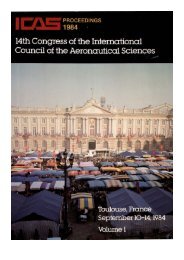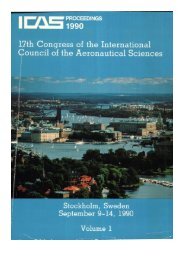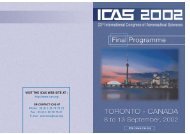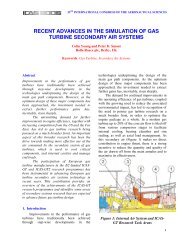computational analyses of supersonic flows over a delta wing at - ICAS
computational analyses of supersonic flows over a delta wing at - ICAS
computational analyses of supersonic flows over a delta wing at - ICAS
You also want an ePaper? Increase the reach of your titles
YUMPU automatically turns print PDFs into web optimized ePapers that Google loves.
Fig. 4 Comput<strong>at</strong>ional grid.<br />
2.3 Flow Conditions<br />
The flow conditions are chosen to c<strong>over</strong> the<br />
classific<strong>at</strong>ion chart <strong>of</strong> Miller and Wood [2].<br />
Free-stream Mach number M ∞ c<strong>over</strong>s from 0.4<br />
to 3.2 (increment<strong>at</strong>ion by 0.4), angles <strong>of</strong> <strong>at</strong>tack<br />
from 4 to 24 degrees (increment<strong>at</strong>ion 4 degrees).<br />
Figure 5 shows the flow conditions plotted <strong>over</strong><br />
the classific<strong>at</strong>ion chart <strong>of</strong> Miller and Wood [2].<br />
The selected Reynolds number based on the<br />
<strong>wing</strong> root-chord length is 1.3×10 6 according to<br />
the experiment <strong>of</strong> Miller and Wood [2].<br />
M=0.4 M=0.8 M=1.2 M=1.6 M=2.0 M=2.4 M=2.8 M=3.2<br />
Fig. 5 Flow conditions <strong>of</strong> the present<br />
calcul<strong>at</strong>ions.<br />
2.4 D<strong>at</strong>a Processing<br />
Local time stepping method is used in the<br />
beginning <strong>of</strong> comput<strong>at</strong>ions to converge steady<br />
COMPUTATIONAL ANALYSES OF SUPERSONIC FLOWS OVER A<br />
DELTA WING AT HIGH ANGLES OF ATTACK<br />
solution earlier. After the solutions converge to<br />
certain extent, physical time stepping method is<br />
used in the comput<strong>at</strong>ions. All <strong>of</strong> the flow fields<br />
and the aerodynamic coefficients in the<br />
follo<strong>wing</strong> discussions are based on the timeaveraged<br />
physical variables.<br />
3 Results and Discussions<br />
3.1 Flow Fields<br />
3.1.1 Flow Field Classific<strong>at</strong>ion<br />
In Fig. 6, <strong>comput<strong>at</strong>ional</strong> results are classified<br />
according to the vortex structure in the<br />
crossflow plane <strong>at</strong> 30% chordwise loc<strong>at</strong>ion.<br />
Flows with or without any shock waves are<br />
denoted by open or closed symbols, respectively.<br />
The circular symbols denote th<strong>at</strong> primary and<br />
secondary vortices appear in the flow fields.<br />
The square symbols denote th<strong>at</strong> the <strong>flows</strong> are<br />
domin<strong>at</strong>ed by separ<strong>at</strong>ion bubbles. This figure<br />
shows th<strong>at</strong> the present results are classified into<br />
almost the same types as those in the<br />
experimental results <strong>of</strong> Miller and Wood [2].<br />
Note th<strong>at</strong> the classific<strong>at</strong>ion changes according to<br />
chordwise loc<strong>at</strong>ion as there occur vortex<br />
breakdown in some cases.<br />
vortex breakdown<br />
7(a) 7(b) 7(c) 7(d)<br />
type (I)<br />
type (II)<br />
type (III)<br />
type (IV)<br />
type (V)<br />
type (VI)<br />
Fig. 6 Flow classific<strong>at</strong>ion <strong>of</strong> the present<br />
calcul<strong>at</strong>ion results.<br />
3
3.1.3 Loc<strong>at</strong>ions <strong>of</strong> the Primary Vortex Core<br />
Figure 8 shows how the spanwise positions <strong>of</strong><br />
the primary vortex and its normal distances<br />
from the <strong>wing</strong> surface moves with the increases<br />
<strong>of</strong> the free-stream Mach numbers. They are<br />
measured <strong>at</strong> 30% chordwise st<strong>at</strong>ion. Six cases <strong>at</strong><br />
different angles <strong>of</strong> <strong>at</strong>tack are presented. This<br />
figure shows th<strong>at</strong> the vortex core moves toward<br />
inboard and lower as the free-stream Mach<br />
number increases. An interesting point is th<strong>at</strong><br />
under subsonic free-streams ( M ∞ =0.4 and 0.8)<br />
the normal distance from the wall stays almost<br />
same but under <strong>supersonic</strong> free-stream<br />
conditions ( M ∞ =0.8, 1.2, 1.6, 2.0 and 2.4) it<br />
significantly decreases.<br />
z/c [e-2]<br />
4.0<br />
3.0<br />
2.0<br />
1.0<br />
M=0.8 M=0.4<br />
α α = 24degs<br />
M=1.2<br />
α α = 20degs<br />
M=1.6<br />
α α = 16degs<br />
M=2.0<br />
α α = 12degs<br />
M=2.4<br />
α α = 8degs<br />
α α = 4degs<br />
0.0<br />
0.0 0.2 0.4 0.6 0.8 1.0<br />
root y/b<br />
tip<br />
Fig. 8 Loc<strong>at</strong>ions <strong>of</strong> the primary vortex cores.<br />
Figure 9 shows vorticity contours near the<br />
leading edge <strong>at</strong> 30% chordwise st<strong>at</strong>ion and<br />
different free-stream Mach numbers. This figure<br />
shows th<strong>at</strong> the angle <strong>of</strong> the share layer to the<br />
<strong>wing</strong> surface stays almost the same under<br />
subsonic free-stream conditions ( M ∞ =0.4 and<br />
0.8), but it becomes smaller and smaller as the<br />
Mach number still increases. This nonlinear<br />
move <strong>of</strong> the share layer with increasing Mach<br />
number causes the nonlinear move <strong>of</strong> the<br />
loc<strong>at</strong>ions <strong>of</strong> the primary vortex core in Fig. 8.<br />
Figure 10 shows the local Mach numbers <strong>at</strong><br />
the point A indic<strong>at</strong>ed in Fig. 9. This figure<br />
shows th<strong>at</strong> the <strong>flows</strong> turning around the leading<br />
edge become <strong>supersonic</strong> when M ∞ =1.2 and 1.6.<br />
Once the flow around the leading edge<br />
becomes <strong>supersonic</strong>, the expansion wave from<br />
COMPUTATIONAL ANALYSES OF SUPERSONIC FLOWS OVER A<br />
DELTA WING AT HIGH ANGLES OF ATTACK<br />
the leading edge acceler<strong>at</strong>es the flow and moves<br />
the share layer closer to the surface.<br />
M=1.6<br />
M=1.2<br />
M=0.8<br />
M=0.4<br />
Fig. 9 Share layer near the leading edge <strong>at</strong> α =<br />
20 deg.<br />
local Mach number<br />
1.5<br />
1.0<br />
0.5<br />
0.0<br />
A<br />
0.0 0.4 0.8 1.2 1.6 2.0<br />
free steream Mach number<br />
Fig. 10 Local Mach number <strong>at</strong> Point A.<br />
3.2 Aerodynamic Characteristics<br />
3.2.1 Mach Number Effect on the Normal<br />
Force Coefficients<br />
Figure 11 shows the contours <strong>of</strong> normal force<br />
coefficient CN plotted <strong>over</strong> the classific<strong>at</strong>ion<br />
chart <strong>of</strong> Miller and Wood. Here, CN and local<br />
pressure coefficient Cp are defined as<br />
C<br />
C<br />
N<br />
p<br />
= ∫∫ C dS<br />
surface<br />
p<br />
p − p∞<br />
p − p∞<br />
= =<br />
1 2 1<br />
ρ∞U<br />
∞ γp∞M<br />
2 2<br />
This figure shows CN nonlinearly changes<br />
between M ∞ =0.8 and 1.2. In the flow<br />
conditions M ∞ ≤ 1.<br />
2 , CN increases as Mach<br />
number increases, but CN decreases for the free-<br />
2<br />
∞<br />
5
4 Conclusions<br />
In the present study, subsonic to <strong>supersonic</strong><br />
<strong>flows</strong> <strong>over</strong> a <strong>delta</strong> <strong>wing</strong> <strong>at</strong> high angles <strong>of</strong> <strong>at</strong>tack<br />
have been <strong>comput<strong>at</strong>ional</strong>ly investig<strong>at</strong>ed. The<br />
results show th<strong>at</strong> the nonlinear behavior <strong>of</strong> the<br />
loc<strong>at</strong>ions <strong>of</strong> the primary vortex core between<br />
free-stream Mach number <strong>of</strong> 0.8 and 1.2 with<br />
increasing the Mach number. This nonlinear<br />
behavior occurs as expansion wave from the<br />
leading edge acceler<strong>at</strong>es the flow and shifts the<br />
share layer closer to the surface, when the flow<br />
turning around the leading edge becomes<br />
<strong>supersonic</strong>. The results also show th<strong>at</strong> normal<br />
force coefficient has a different trend below and<br />
above the free-stream Mach number <strong>of</strong> 1.0. This<br />
change <strong>of</strong> normal force characteristics occurs<br />
not <strong>at</strong> the boundary <strong>of</strong> the classific<strong>at</strong>ion <strong>of</strong> main<br />
flow types indic<strong>at</strong>ed by the former studies.<br />
When the free-stream Mach number becomes<br />
<strong>supersonic</strong>, the components <strong>of</strong> threedimensional<br />
flow structure such as primary<br />
vortex, vortex breakdown and windward flow<br />
has a different n<strong>at</strong>ure, which lead to the<br />
nonlinear behavior <strong>of</strong> aerodynamic<br />
characteristics.<br />
References<br />
[1] Stanbrook A. and Squire L. C. Possible types <strong>of</strong> flow<br />
<strong>at</strong> swept leading edges. Aeronautical Quarterly,<br />
Vol.15, No. 2, pp 72-82, 1964.<br />
[2] Miller D. S and Wood R. M. Leeside Flows <strong>over</strong><br />
<strong>delta</strong> <strong>wing</strong>s <strong>at</strong> <strong>supersonic</strong> speeds. Journal <strong>of</strong> Aircraft,<br />
Vol. 21, No. 9, pp 680-686, 1984.<br />
[3] Szodruch J. G and Peake D. J. Leeward flow <strong>over</strong><br />
<strong>delta</strong> <strong>wing</strong>s <strong>at</strong> <strong>supersonic</strong> speeds. NASA-TM, No.<br />
81187, 1980.<br />
[4] Seshadri S. N and Narayan K. Y. Possible types <strong>of</strong><br />
flow on lee-surface <strong>of</strong> <strong>delta</strong> <strong>wing</strong>s <strong>at</strong> <strong>supersonic</strong><br />
speeds. Aeronautical Journal, No. 5, 185-199, 1988.<br />
[5] Brodetsky M. D, Krause E, Nikiforov S. B, Pavlov A.<br />
A, Kharitonov A. M, and Shevchenko A. M.<br />
Evolution <strong>of</strong> vortex structures on the leeward side <strong>of</strong><br />
a <strong>delta</strong> <strong>wing</strong>. Journal <strong>of</strong> Applied Mechanics and<br />
Technical Physics, Vol. 42, No. 2, pp 242-254, 2001<br />
[6] Wada Y. and Liou M. S. A flux splitting scheme with<br />
high-resolution and robustness for discontinuities.<br />
AIAA paper, 94-0083, 1994<br />
[7] Van Leer B. Toward the ultim<strong>at</strong>e conserv<strong>at</strong>ive<br />
difference scheme. 4. Journal <strong>of</strong> Comput<strong>at</strong>ional<br />
Physics, Vol. 23, pp 276-299, 1977.<br />
COMPUTATIONAL ANALYSES OF SUPERSONIC FLOWS OVER A<br />
DELTA WING AT HIGH ANGLES OF ATTACK<br />
[8] Fujii K. and Obayashi S, Practical applic<strong>at</strong>ions <strong>of</strong><br />
new LU-ADI scheme for the three-dimensional<br />
Navier-Stokes comput<strong>at</strong>ion <strong>of</strong> transonic viscous<br />
<strong>flows</strong>. AIAA paper, 86-513, 1986.<br />
[9] Baldwin B and Lomax H. Thin layer Approxim<strong>at</strong>ion<br />
and algebraic model for separ<strong>at</strong>ed turbulent <strong>flows</strong>.<br />
AIAA paper 78-257, 1978.<br />
9






